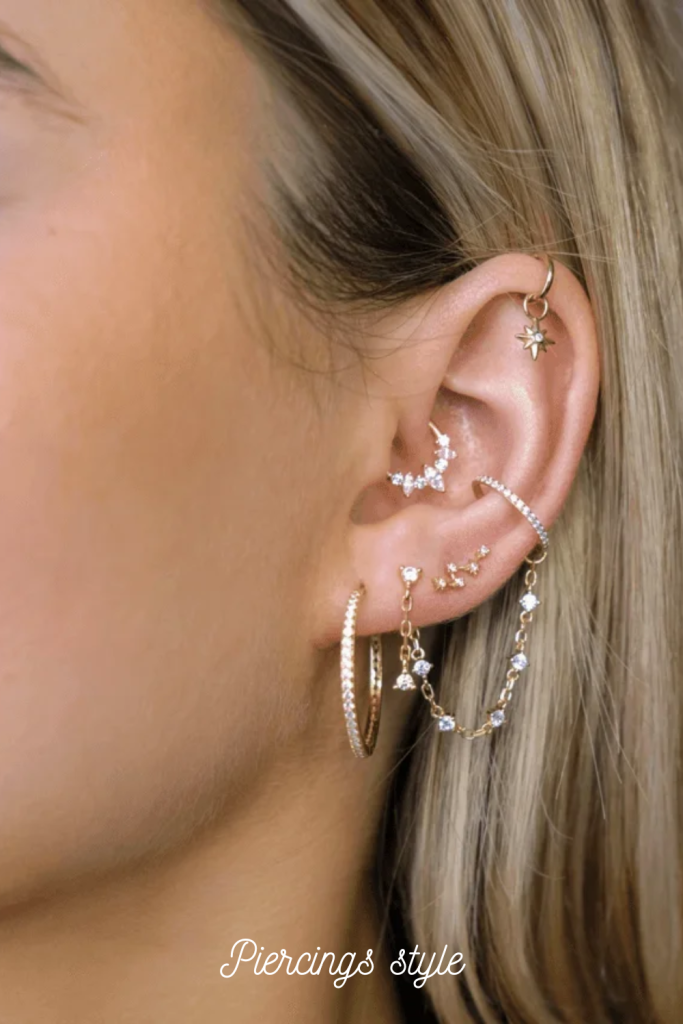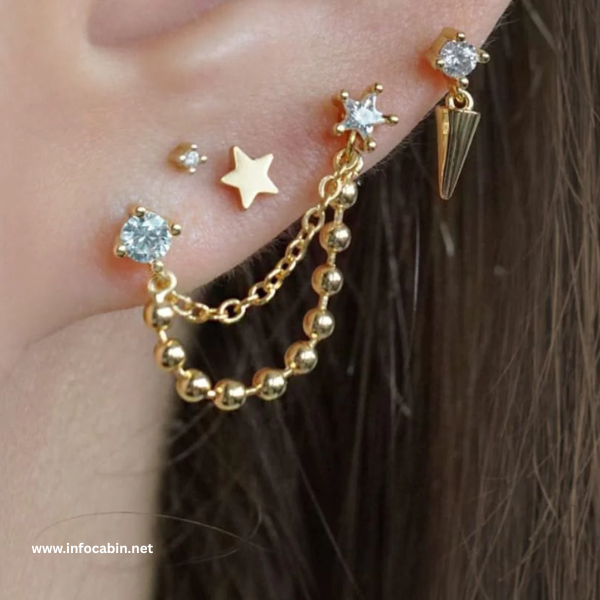Table of Contents
Quick answer: “how many piercings can i get at once”?
Short version: there’s no one-size-fits-all number. Many studios will do multiple earlobe piercings in one session (often 2–4), while cartilage, nostril, or oral piercings usually get spaced out. The real answer depends on placement, your health, the piercer’s policies, and how well you can follow aftercare. So — yes, you can get several at once, but whether you should is a different question.
Why people love getting multiple piercings
Why do folks go for multiples? Some reasons:
- Aesthetic impact — symmetry, clusters, curated ear looks.
- Convenience — getting everything done in one trip saves time.
- Cost-efficiency — sometimes one trip lowers per-piercing fees.
- Emotional momentum — once you commit, it’s easy to want more!
But enthusiasm should be matched with caution. Think of multiple piercings like planting a garden: the more seeds you bury at once, the more attention each sprout needs.
Factors that determine how many piercings you can get at once

Anatomy and placement matter
Different parts of the body heal differently. Earlobes are soft and forgiving; cartilage is denser and slower to heal. A single piercer will assess the anatomy first — are there enough millimetres between intended holes? Is the cartilage shape suitable? If the anatomy doesn’t allow safe spacing, the piercer will limit the number.
Earlobe vs cartilage: big differences
Earlobes: generally heal fast and tolerate multiple piercings.
Cartilage (helix, tragus, conch): slower healing, higher risk of complications, and often treated more cautiously.
Practical Tips for Getting Multiple Piercings

1. Listen to Your Piercer
Your piercer is the expert—they know anatomy, healing patterns, and jewelry placement better than most. If they recommend waiting between piercings or suggest certain jewelry, take their advice seriously. Good piercers won’t just give you what you want; they’ll make sure it’s safe and realistic for your body.
2. Start with Easiest-to-Heal Areas
If you’re new to multiple piercings, begin with areas that heal quickly and with fewer complications. Lobe piercings are usually the fastest and least painful, making them a great foundation. Once you’ve built up experience (and patience with aftercare), you can move to cartilage, nose, or more complex placements that take longer.
3. Stick to One Side
If you want several piercings, it’s smarter to do them on one side at a time. That way, you’ll still have one comfortable side to sleep on and fewer chances of irritating both ears. Later, once the first side is mostly healed, you can balance things out with piercings on the other side.
4. Get the Right Jewelry
The jewelry you start with makes a huge difference in healing. Always choose implant-grade titanium, surgical steel, or solid gold (14k+). These materials are safe, less likely to cause reactions, and comfortable for long-term wear. Avoid cheap alloys, nickel, or low-quality fashion jewelry, especially during the healing phase.
Type of piercing and complexity
A simple stud through a soft earlobe is quick; a complex surface or dermal anchoring takes longer and needs precision. If multiple complex piercings are requested, a piercer may break them into multiple appointments.
Healing time and overlapping aftercare
If you get seven new ear holes at once, you’ll manage seven healing wounds simultaneously. Aftercare becomes more intense and time-consuming. Also, healing tissues can irritate one another if too close.
Your health and immune system
Chronic conditions (like diabetes), certain medications (blood thinners, some immune suppressants), or a history of keloids all influence the piercer’s decision. Always disclose medical history honestly.
Pain tolerance and anesthesia considerations
If you faint, feel nauseous, or have anxiety during procedures, a piercer might recommend fewer piercings in one session. Numbing creams are available for some places but aren’t a magic fix — they don’t eliminate infection risk or healing needs.
Studio policy, legal age, and consent
Studios set rules: some have strict limits on how many piercings per session, others are more flexible. Minors may need parental consent and studio rules vary by region. Always check beforehand.
How professional piercers decide
Cleaning, sterilization and workspace flow
Piercers balance safety and efficiency. If doing multiple piercings, they will ensure tools and needles are sterile and that the workflow minimizes cross-contamination. Expect each piercing to be prepped and executed like a mini-procedure.
Staffing and time-per-piercing
If a studio has more staff, multiple piercings can be handled more comfortably (one piercer can work on one ear while another does the other). Solo piercers may limit numbers to maintain focus and safety.
Practical limits and typical numbers
What many studios commonly allow
- Earlobes: 2–4 in one session often permitted (depends on spacing).
- Cartilage: usually 1–2, sometimes more if spaced well.
- Nostril + septum: sometimes allowed together; variable.
- Tongue, lip: often done alone or paired with similar-pace oral piercings.
When piercers say “no” — why
- Too close spacing risking migration or splitting.
- Client medical issues or poor aftercare history.
- High risk of vasovagal reaction (fainting).
- Studio policy for legal or insurance reasons.
Aftercare for multiple new piercings
Daily routine
- Wash hands before touching.
- Clean with sterile saline (spray or soak) twice daily.
- Gently pat dry with clean paper towel.
- Avoid rotating or twisting jewelry — that can irritate.
- Keep hair, hats, and headphones away from new piercings until healed.
What to avoid
- Swimming in pools, hot tubs, lakes during early healing.
- Harsh disinfectants (rubbing alcohol, hydrogen peroxide) — they damage new tissue.
- Sleeping directly on the new piercing if possible.
- Changing jewelry too early.
Signs of trouble
Redness is normal at first, but watch for increased pain, pus that’s yellow/green with odor, spreading redness, fever, or warm skin — these suggest infection and need professional attention.
Healing timelines overview
Earlobe healing timeline
Earlobes typically heal fastest — think 6–8 weeks for many people, but full internal healing can take months. If you’ve had multiple lobes done, expect to baby them for that period.
Cartilage healing timeline
Cartilage can take months — commonly 3–12 months depending on location and individual healing. Because of this, cartilage piercings are often staggered.
Oral piercings healing timeline
Tongue piercings heal faster externally (4–8 weeks) but you need careful oral hygiene. Lip and labret can take longer and are affected by saliva bacteria and eating habits.
(These are general ranges — everyone heals differently.)
Cost and appointment planning
Getting many piercings in one visit might save time, but don’t assume it will be dramatically cheaper. Some studios charge per piercing regardless; others offer small bundle discounts. Factor in travel, aftercare supplies, and potential follow-up visits.
When to stagger vs do all at once
Advantages of a one-session approach
- Fewer visits — convenient.
- Uniform look achieved quickly.
- Single day of soreness and recovery time off if you plan it.
Advantages of a staggered approach
- Monitored healing — less risk of overwhelming your immune system.
- Easier aftercare focus — fewer wounds at once.
- Ability to react to any complications before adding more.
Real-life examples and scenarios
- The “cartwheel” ear: someone gets three lobe piercings in a cluster and one helix the same day; the piercer allowed it because spacing and client health were ideal.
- The “split schedule”: another client did one nostril and waited six weeks before septum due to swelling concerns.
- The “oops” case: someone got four cartilage piercings at once and experienced irritation and swelling requiring follow-up care — a reminder that more is not always better.
Checklist before booking multiple piercings
- Are you medically fit? (Be honest.)
- Have you researched the studio? (Clean, licensed, good reviews.)
- Is the piercer experienced with the placements you want?
- Do you understand aftercare time and restrictions?
- Do you have time to rest and avoid swimming / contact sports soon after?
Conclusion
So — how many piercings can you get at once? Technically, multiple piercings are possible in one session, especially in forgiving areas like earlobes. But “can” does not always mean “should.” The safest choice balances anatomy, the piercer’s professional judgment, your health, and your commitment to aftercare. Think of a piercing session like a small surgery: the quality of the work and the healing process matters far more than checking boxes. Whether you’re considering a classic lobe piercing or something more unique like a Floating Helix Piercing, it’s best to talk openly with a reputable piercer — they’ll tell you whether to go for a mini piercing spree or to space things out for the best long-term result.
FAQs
1. How many ear piercings can I safely get at once?
You can often get 2–4 earlobe piercings in one visit if spacing and anatomy allow. Cartilage piercings are treated more cautiously — many piercers prefer fewer per session.
2. Will getting multiple piercings at once increase my infection risk?
It can if aftercare is neglected or if piercings are too close. Multiple clean wounds mean more to care for; follow studio aftercare exactly and avoid swimming or dirty environments while healing.
3. Is it painful to get several piercings in one session?
Pain varies person to person. The procedure itself is quick; soreness afterward accumulates with multiple sites. If you’re anxious about pain or fainting, consider staggering.
4. Can I change jewelry right after getting multiple piercings?
No. Leave the initial jewelry in place until a piercer confirms the piercing is sufficiently healed. Changing too early can cause irritation or migration.
5. I have diabetes / take certain meds — can I still get several piercings at once?
Medical conditions and medications can affect healing. Always disclose health info to your piercer and consult your doctor if unsure. They may recommend fewer piercings at a time or specific precautions.

